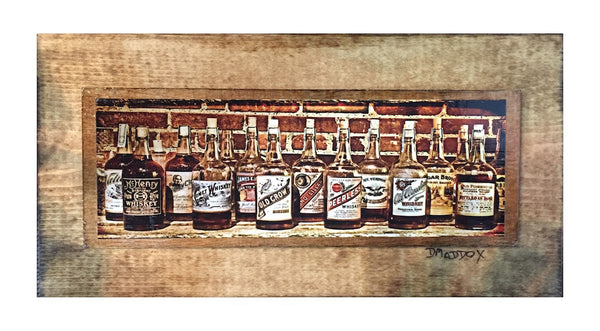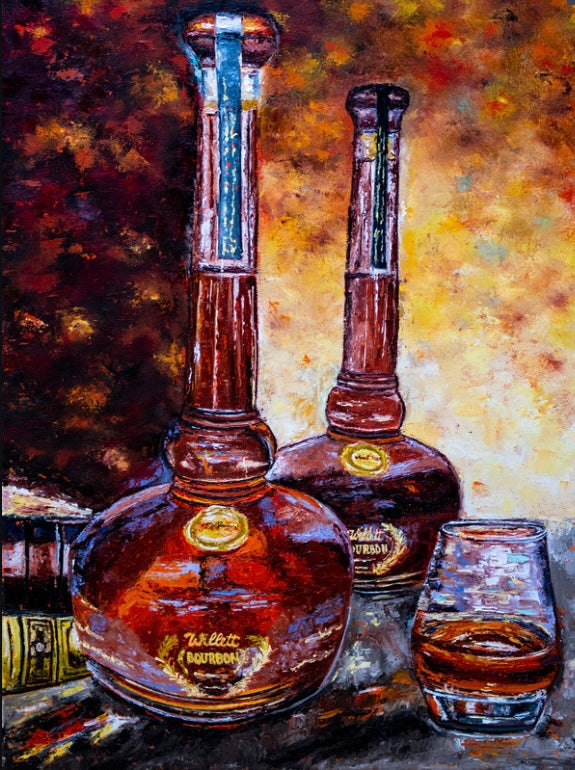Transform Your Space with Stunning Whiskey Art Inspired by Nature
Capturing the Essence of Whiskey Art Via Special Visual Depictions and Styles
The art of scotch prolongs beyond the fluid itself, materializing via a range of aesthetic representations that encapsulate its storied heritage and workmanship. What stays to be discovered is exactly how these progressing styles mirror not just the whiskey itself however additionally the altering landscape of creative interpretation. Bourbon Art.
The History of Bourbon Art

As scotch production spread, so too did the need to raise its experience with art. From the intricate engravings on very early barrels to the sophisticated tags of contemporary containers, each aspect mirrors a distinct artistic vision, offering as an aesthetic narrative of the whiskey's heritage.
In the 19th and 18th centuries, the rise of the commercial transformation better boosted whiskey art, causing innovative packaging and advertising that caught customer focus. Designers and artists began trying out visual appeals, imbuing whiskey-related images with symbolic meanings that conveyed notions of craftsmanship, tradition, and community.
Today, scotch art remains to evolve, mixing conventional methods with modern art types. Realism Art. This continuous dialogue in between the spirit and its visual depiction underscores the long-lasting bond between whiskey and society, enriching the general experience for fanatics worldwide
Iconic Bottle Designs
While numerous aspects add to the attraction of bourbon, famous container layouts play a pivotal duty in shaping customer assumption and improving the overall experience. The visual presentation of whiskey bottles is not merely an aesthetic factor to consider; it works as a bridge in between the customer and the item, evoking feelings and setting expectations.
Distinctive forms, materials, and closures can raise a bourbon brand's identification, making it promptly well-known on jampacked racks. For instance, the traditional Glenfiddich bottle, with its stylish tapered silhouette, conveys a sense of tradition and workmanship, while the vibrant, modern-day layout of the Balvenie container reflects development and sophistication. Additionally, using tinted glass or special appearances can suggest the quality and character of the whiskey within.
Legendary designs frequently incorporate elements of social heritage, symbolizing the brand name's background and link to its roots. Brand Names like Jack Daniel's utilize a straightforward, robust design that reverberates with its American scotch heritage. Eventually, the influence of bottle layout prolongs beyond mere capability; it encapsulates the significance of the brand name, inviting consumers to delight and explore in the rich tapestry of bourbon culture.
Tag Art Work and Branding
Container layouts usually set the phase of what customers can expect, yet label art work and branding play a similarly substantial role in interacting a scotch's identity. The tag works as the initial factor of call in between the item and the customer, encapsulating the essence of the scotch within its visual elements.
Efficient tag art work incorporates shade, images, and typography to create a narrative that resonates with the brand's heritage and target market. For example, a tag featuring classic font styles and intricate pictures might stimulate a sense of tradition and craftsmanship, appealing to aficionados. On the other hand, bold colors and contemporary layout elements might attract a younger group looking for development and exhilaration.


Digital Photography and Visual Storytelling
Catching the significance of bourbon through photography and visual storytelling is an art kind that boosts the brand name experience. This medium transcends simple product representation, diving into the detailed narratives that surround each bottle. By utilizing engaging images, photographers can evoke emotions that resonate with consumers, eventually building a much deeper link to the bourbon brand name.
Visual storytelling in whiskey photography frequently uses rich structures, illumination, and structure to highlight the one-of-a-kind features of the spirit. The interaction of light and darkness can highlight the brownish-yellow colors of bourbon, while the selection of history components-- such as rustic barrels or sophisticated glassware-- can strengthen the brand's heritage or way of life associations.
Furthermore, capturing the ritualistic facets of bourbon consumption, from the putting to the sampling, welcomes customers right into a sensory experience, allowing them to think of the tastes and fragrances that wait for. Each photo not only showcases the product yet likewise tells a story of workmanship, practice, and the moments that whiskey can boost - Realism Art. Therefore, photography becomes an effective device in articulating the identification of bourbon brands, positioning them within the more comprehensive social landscape
Emerging Fads in Scotch Art
The evolution of look at this site bourbon art is increasingly shaped by modern patterns that mirror broader societal changes and consumer preferences. This change not only highlights the value of sustainability but likewise boosts the narrative bordering whiskey manufacturing.
Furthermore, digital art has risen in appeal, permitting ingenious depictions of bourbon. Artists are leveraging innovation to craft immersive experiences, such as augmented truth installments that engage audiences and supply a much deeper understanding of whiskey's cultural relevance. This fad also prolongs to social media sites systems, where aesthetically striking material gathers focus and cultivates community among enthusiasts.
In addition, collaborations in between scotch brand names and musicians are becoming more widespread. These collaborations produce limited-edition my sources product packaging layouts and unique art work that commemorate both the craftsmanship of whiskey and the creativity of artists. As whiskey art remains to evolve, these emerging trends will unquestionably shape its future, promoting a dynamic crossway of culture, sustainability, and technology within the whiskey community.
Conclusion
In conclusion, the art of bourbon incorporates a varied variety of graphes that show its rich heritage and workmanship. From legendary container styles and elaborate label art work to engaging photography, each element adds to a wider narrative that enhances the customer's experience. As arising trends, such as digital art and sustainability, remain to form this imaginative landscape, the multifaceted identification of whiskey continues to be a withstanding source of social link and expedition.

In conclusion, the art of whiskey incorporates a varied variety of visual depictions that show its rich heritage and craftsmanship.